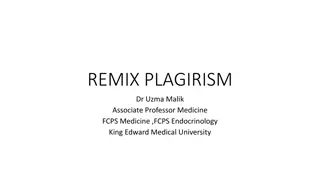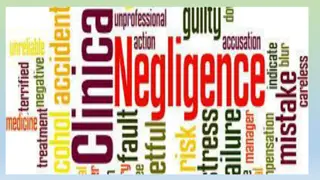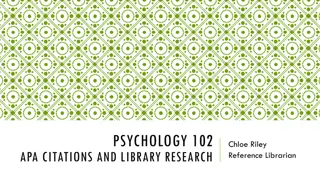Understanding Plagiarism and Academic Negligence in Academic Writing
This content discusses the definitions of plagiarism and academic negligence, the importance of citing sources, and the consequences of academic dishonesty according to the LCC Student Code of Conduct. It emphasizes the necessity of acknowledging sources to give credit, establish credibility, and avoid plagiarism accusations. The text explores the differences between learning and plagiarism, providing insights into proper research practices and ethical writing behavior in academic settings.
Download Presentation

Please find below an Image/Link to download the presentation.
The content on the website is provided AS IS for your information and personal use only. It may not be sold, licensed, or shared on other websites without obtaining consent from the author. Download presentation by click this link. If you encounter any issues during the download, it is possible that the publisher has removed the file from their server.
E N D
Presentation Transcript
The Writing Center Plagiarism and Plagiarism and Academic Negligence Academic Negligence Last Updated: 8 April 2022 1
In this session, you will. . . Define and identify plagiarism and academic negligence Review key terms Understand paraphrasing, summarizing, and quoting Review the basics of citations Access resources for these topics 2
Discussion 1. Why do you cite sources? 2. What is plagiarism? 3
Your experiences with research and writing What experiences have you had with citation? 4
Why acknowledging sources is necessary To give credit to other people for their words, ideas, and research To provide solid, credible support for your ideas To increase readers trust that you have done your research well To protect yourself from being accused of plagiarism or academic negligence 5
What is plagiarism? The LCC Student Code of Conduct defines the term plagiarism as follows: the use, by paraphrase or direct quotation, of the published or unpublished work of another person without full and clear acknowledgment. It also includes the unacknowledged use of materials prepared by another person or agency engaged in the selling of term papers or other academic materials (Lansing Community College Student Code of Conduct). 6
What is academic negligence? The LCC Student Code of Conduct defines the term academic negligence as follows: Academic Negligence means unknowingly or unintentionally claiming credit for the work or effort of another person (Art.1, Student Code of Conduct). It also includes the failure to fully and clearly attribute the work of others incorporated into one's own work. Academic Negligence often involves the lack of skill/knowledge on the part of the student, and usually is resolved as the student progresses through the semester and learns about attribution and documentation. Engaging in academic negligence is a violation of the Student Code of Conduct (Lansing Community College Student Code of Conduct). 7
Learning Learning vs. vs. Plagiarism Plagiarism Plagiarism involves: Taking short cuts in the learning process by eliminating the need for asking, researching, and responding in an informed way Taking someone else s words and ideas and claiming them as your own Devaluing the learning institution and the degrees it offers The learning process involves: Asking questions Seeking answers through course material, reading, and research Creating an opinion based upon research Acknowledging the source of the information ("Defining and Avoiding Plagiarism ) 8
Is this plagiarism? Using your own words, ideas, and experiences No Summarizing words written by other authors without acknowledging the source Yes Writing about common knowledge topics No Copying words from a book written by other authors without acknowledging the source Yes (Bartzis; Frick, et al.) 9
10 ( Plagiarism.jpg )
Do you need to cite? Did you borrow ideas from someone else? Yes No Is at least one idea taken from the original source a direct word-for-word quote? If the ideas you write about are either common knowledge or your own ideas, you do not need to cite them. Yes No Make sure that the direct word-for-word quote contains the following: Be sure that the summarized or paraphrased idea includes the following: Quotation marks In-text citation with a page number, if available An entry on the list of resources (Works Cited, References, etc.) In-text citation An entry on the list of resources (Works Cited, References, etc.) (Frick, et al.)
Three ways of incorporating source material Paraphrasing All three of these Summarizing require a citation. Quoting 12
Paraphrasing What is it? A paraphrase is used to restate a short passage (a sentence, for example) from a source in your own words. A paraphrase is often about the same number of words if not more words than the original passage. Why use it? Paraphrasing is used to provide a less technical explanation of the research to a general audience of readers. Paraphrasing is also used to ensure that the dominant voice in your writing is your own (in other words, to prevent quoted material from taking over ). It is also used to demonstrate to readers that you understand the source information by explaining it in your own words. Image from Pell 13
How to paraphrase Read the passage (more than once, if necessary!). Look up unfamiliar vocabulary. Identify the passage's main point and supporting details. Put the passage in your own words; change wording AND grammatical structure. Double-check that you have not changed the meaning. Include an in-text citation and entry on your list of resources. 14
Paraphrasing example exercise Please read the following sentence and determine which of the sentences below is the best paraphrase: "College students often struggle with financing their education." Paraphrase 1: College students frequently have a hard time paying for their schooling. Paraphrase 2: Financing their education is often a struggle for college students. Paraphrase 3: Obtaining financial assistance is a necessity for many undergraduates. 15
Summarizing What's a summary? A summary is a greatly condensed version of an original text that includes the main points and not the writer s personal opinion (Min). A newspaper article might be summarized in 3 or 4 sentences. Why summarize? To highlight the main points from a reading 16
How to summarize Read the text (more than once!). Identify main points and supporting details. Find keywords. Restate only the main ideas in your own words. Check by rereading the original. Do not include your own opinion. Make clear where the summary begins and ends. Cite the source. (Carroll) 17
Quoting What is quoting? Using a specific, vividly-worded phrase, sentence, or exact wording from the source Borrowing word-for-word without putting the passage into your own words When you copy exact wording (Frick, et al.) 18
Quoting When should you quote? Writers often use a direct quote to preserve vivid, precise, or technical language, or to let the author speak in their own words. Using a direct quote should not be your first choice. Paraphrasing is usually better if you can communicate the same message in your own words. 19
Paraphrasing, summarizing and quoting: Similarities and differences Paraphrasing Summarizing Quoting Using your own words is: Rewording a specific sentence to make it more understandable for readers is: Providing an overview of key points from a whole paper, article, or book is: Using about the same number of words to convey the meaning of the original source is: Using a sentence verbatim from the source is: You should include an in-text citation and entry on a Works Cited page when you are: (Min) 20
Citation styles Modern Language Association (MLA) American Psychological Association (APA) Chicago Manual of Style (CMS) And many, many others . . .over 200 styles! 21
Citation basics: Two parts To acknowledge your sources, you must provide two things: In-text citations throughout the body A list of the resources you referenced on the last page(s), often called a "References" page or "Works Cited" page In-text citations tell readers where you are inserting source information within your writing. Typically, the in-text citation contains the author's last name and other information that provides a link to the full citation in the Works Cited/References page. 22
When to use an in-text citation An in-text citation generally appears at the end of a summary, paraphrase, or quoted material inside parentheses. The material included inside the parentheses will depend on the requirements of the citation style you are following. Consult appropriate resources to determine what should be included in the in-text citation for the citation style you are following. 23
Use signal phrases A signal phrase is a word or words that introduce information from another source ( Using Signal Phrases Effectively ). 24
Common signal phrases According to (author), As (author) observed / illustrates / verbs from list below, As described in (article / book title / source), As noted (in the article / on their website), In (article title), (author) describes In the words of (author[s]), (author[s]) points out / examines / offers a persuasive counterargument / etc. The (organization / study) shows / indicates / reveals 25
After examining source material to decide whether you want to summarize, paraphrase, and/or quote word-for-word, you will want to integrate the material into your writing smoothly. 1. Ensure that you signal into the source material. 2. Add the summary, paraphrase and/or quote (with proper punctuation). 3. Ensure that you signal out of borrowed material, too. 4. Include an in-text citation at the end of the borrowed material, following the appropriate format. 26
Consider the following web page: https://www.cadl.org/about/who-what-why/mission-history ("Who, What & Why: Overview") How might you integrate information from the "Our Services" and "Our Mission" sections of the web page? How might you summarize the information? What information might you paraphrase? How would you paraphrase it? What parts might you quote? 27
Citation resources The Pocket Style Manual Style Guides Purdue Owl Citation generators* Screenshot from knightcite.com *Caution: Online citation tools can make mistakes! If you use a citation generator, double check that your entries are correct. 29
Other campus resources Instructor's office hours (located on the course syllabus) The Writing Center (in person, WebEx) Visit lcc.edu/writingcenter to schedule an appointment. LCC Library Online Plagiarism guide: https://libguides.lcc.edu/c.php?g=167850&p=1102940 Research guides Ask a Librarian (in person, phone, WebEx, online chat)
To complete your Academic Negligence requirement for the Office of Student Compliance: Complete a follow-up writing assignment: You may choose to (1) address the plagiarism in your previously-submitted written work and turn in a revised version, or (2) write a 300-350-word reflection on what you learned in the academic negligence session with the Writing Center. Fill out the Session Completion Form Submit the form and the written assignment via email to lcc- osc@star.lcc.edu and cc the Writing Center Staff member and the Writing Center (writingctr@lcc.edu). 31
Works Cited Bartzis, Opal L. "'Cheating' or 'Sharing'? Academic Ethics Across Cultures." American Association of Collegiate Registrars and Admissions Officers (AACRAO) Conference, Apr. 2009, library.wcupa.edu/ld.php?content_id=2185829. Carroll, Hollie. "ESL Summarizing: What, How, and Why." Medium, 11 Nov. 2016, medium.com/@holliecarroll/esl-summarizing-what-how-and-why- a84dfefa3f3b. "Defining and Avoiding Plagiarism: The WPA Statement on Best Practices." Council of Writing Program Administrators, 30 Dec. 2019, wpacouncil.org/aws/CWPA/pt/sd/news_article/272555/_PARENT/layout_details/false. Frick et al. How to Recognize Plagiarism: Tutorial and Tests, 27 May 2021, plagiarism.iu.edu. Lansing Community College Student Code of Conduct.7 May 2021, www.lcc.edu/academics/documents/pdf-policies/student-code-of-conduct.pdf. Min, Young-Kyung. "ESL: Source Use & Synthesis Skills." University of Washington Bothell, www.uwb.edu/wacc/for- students/eslhandbook/sourceuseandsynthesis. Accessed 5 Jan. 2018. Pell, Christopher. "How to Paraphrase in the IELTS Test." IELTS Advantage, 2021, www.ieltsadvantage.com/2015/03/31/paraphrase-ielts. Plagiarism.jpg. Macomb Reading and Writing Studios, online.macomb.edu/courses/3798/files/2652579?module_item_id=402569. Accessed 9 Nov. 2021. "Using Signal Phrases Effectively." Naval Postgraduate School s Graduate Writing Center and Thesis Processing Office, 20 June 2019, nps.edu/documents/105790666/106471207/Signal_Phrases.pdf. "Who, What & Why: Overview." Capital Area District Libraries, 2022. www.cadl.org/about/who-what-why/mission-history. Accessed 31 Mar. 2022. 32























